The Ajanta Caves › Alexander the Great: A Case Study in Martial Leadership » Origins and History
Articles and Definitions › Contents
- The Ajanta Caves › Ancient History
- Alexander the Great: A Case Study in Martial Leadership › Antique Origins
Ancient civilizations › Historical places, and their characters
The Ajanta Caves › Ancient History
Ancient Civilizations
The 30 caves at Ajanta lie to the north of Aurangabad in the Indhyadri range of Western Ghats. The caves, famous for their temple architecture and many delicately drawn murals, are located in a 76 m high, horseshoe-shaped escarpment overlooking the Waghora (tiger) River.
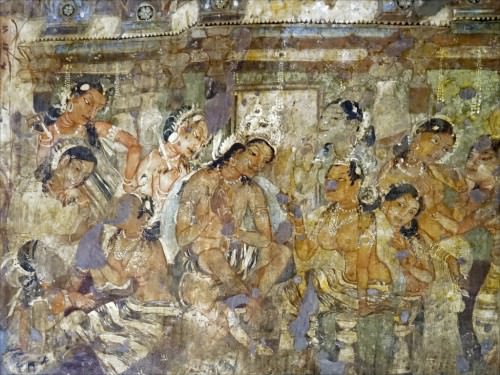
Jataka Image in Ajanta
Cave 1
This is a vihara (monastery), therefore squarish in plan consisting of an open courtyard and verandah with cells on each side, a central hall sided by 14 cells, a vestibule and garbha griha (inner sanctum). Though located at a less than an ideal position of eastern extremity of the ravine its beautifully executed paintings, sculptural and architectural motifs make this cave truly fit for a king; for this is the “regal” cave patronised by Emperor Harisena.
It contains the famed paintings of Bodhisvattas Padmapani and Vajrapani along with a seated figure of Buddha in dharma chakra pravartana mudra in the sanctum. Other notable features include murals that depict Sibi, Samkhapala, Mahajanaka, Mahaummagga, Champeyya Jatakas and temptation of Mara.
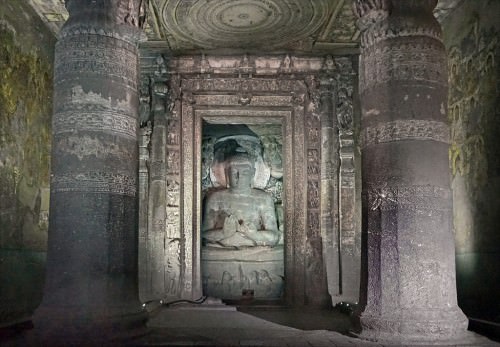
Buddha Sculpture in Ajanta
Cave 2
This vihara consists of a porch with cells on either side, a pillared hall bound by ten cells, an antechamber and garbha griha.Most importantly this cave contains two sub-shrines. Buddha in the main shrine is flanked by two y aksha figures ( Sankhanidhi and Padmanidhi ) on the left and two others ( Hariti & her consort Pancika ) on the right. Beautifully decorated cave walls and ceiling portray Vidhurapandita & Ruru Jatakas and miracle of Sravasti, Ashtabhaya Avalokitesvara and the dream of Maya.
Cave 3
This is an incomplete vihara consisting only of a pillared verandah.
Cave 4
The largest vihara in Ajanta has its façade richly ornamented with sculpted figure of Bodhisvatta as a reliever of eight great perils among others. As usual, the construction follows the basic pattern of a pillared verandah with adjoining cells leading to a central hall sided by another group of cells, an antechamber and finally garbha griha. An interesting geological feature here is notable on the ceiling which gives a unique impression of a lava flow.

Buddha with His Disciples
Cave 5
This is an unfinished excavation that proceeded only to carve out a porch and for the most part an incomplete interior hall. By the standards of Ajanta this structure is denuded of any architectural and sculptural motifs save the ornate door frame detailing female figures of makaras.
Cave 6
This two storied structure is referred to as Cave 6 Lower and Cave 6 Upper. Both stories contain an enshrined Buddha. The pillared porch, if there was any, of Cave 6 Lower does not survive today. It is also believed that the upper floor was an afterthought when the excavation of the lower level was well underway. There are some striking examples of murals preserved in the shrine and antechamber of the lower cave. In both the caves, Buddha is seen in various moods.
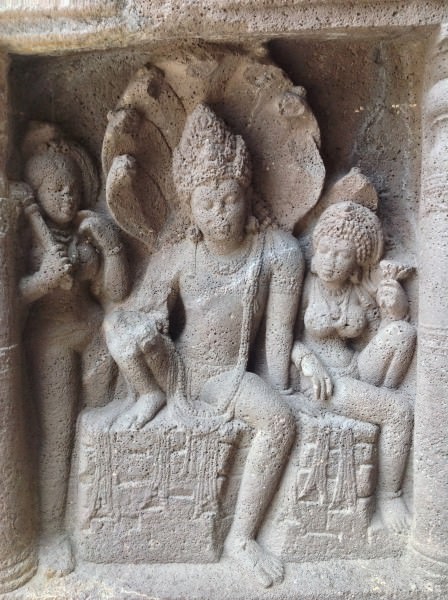
Nagaraja, Ajanta
Cave 7
This vihara consists of two small porticoes supported by octagonal pillars with eight cells, a central hall rather oblong in shape and the garbha griha with Buddha in preaching pose. Sculptures abound, one of the more notable panels depicts a seated Buddha sheltered by Naga Muchalinda (the many-headed snake king).
Cave 8
Perhaps the earliest monastery, belonging to the Satvahana phase of excavation, this cave is located at the lowest level and a major portion from the front of the structure has been swept away by a landslide. Few architectural details survive but, importantly, the sanctum does not contain an image of Buddha.
Cave 9
Excavated in the 1st century BCE, this is one of the oldest chaitya (prayer halls) in Ajanta. The nave is flanked by aisles on either side separated by a row of 23 pillars with the stupa at the far end. The ceiling of the nave is vaulted but that of the aisles is flat. The stupa stands on a high cylindrical base at the centre of the apse. Signs of wooden rafters and beams on the ceiling, façade and tapered octagonal pillars show an adherence to the contemporary wooden architectural style. The paintings here belong to two different eras - the first being at the time of excavation while a repainting of the cave interior was carried out in the later phase of activity, around the 5th century CE.
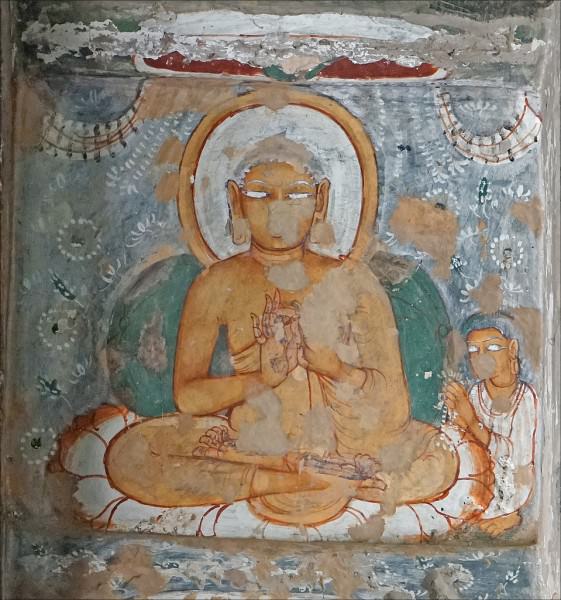
Buddha, Ajanta Cave No. 10
Cave 10
This is the earliest chaitya in the cave complex having been built in 2nd century BCE. The nave is separated from the aisles by 39 octagonal pillars with the stupa being located at the apsidal end. Having been repainted in the later phase the cave contains paintings from two different periods. The scenes depict worship of Bodhi tree and stories from Sama and Chhaddanta Jatakas. The heavy begriming of the surface reveal that it was in use together with cave 9 over the centuries, though perhaps not continuously. A Brahmi inscription reads that the façade was a gift of “Vasithiputa Katahadi.”
Cave 11
This is a vihara, datable to the early 5th century CE, typically consisting of a pillared verandah with four cells, a hall with six cells and a long bench and the garbha griha which, besides the image of Buddha in preaching attitude, also contains an unfinished stupa.
Cave 12
Paleographically datable from the 2nd to 1st century BCE, this vihara was probably excavated slightly after Cave 10. The front of this monastery has collapsed completely. Only the central hall with four cells in each of its three inner sides remains. Each cell is provided with double beds with raised stone pillows. The cell frontage is ornamented with chaitya window motifs above each door. An inscription records this monastery to be a gift of a merchant named Ghanamadada.

Mural, Ajanta Caves
Cave 13
This is a rather small vihara from the first phase, possibly 1st century CE, consisting of a central astylar hall with seven adjoining cells distributed on three sides.
Cave 14
Excavated above cave 13, this is an unfinished vihara. Though initially planned on a large scale it hardly progressed beyond the front half. A beautiful depiction of Salabhanjika (a woman breaking a branch of a Shorea tree) on the top corner of the doorway is to be noted.
Cave 15
This vihara was excavated around the middle of the 5th century CE. The plan follows the general vihara format of pillared porch with a cell at each end, an astylar hall accompanied by eight cells, an antechamber and finally a sanctum sanctorumwith a sculpture of Buddha.
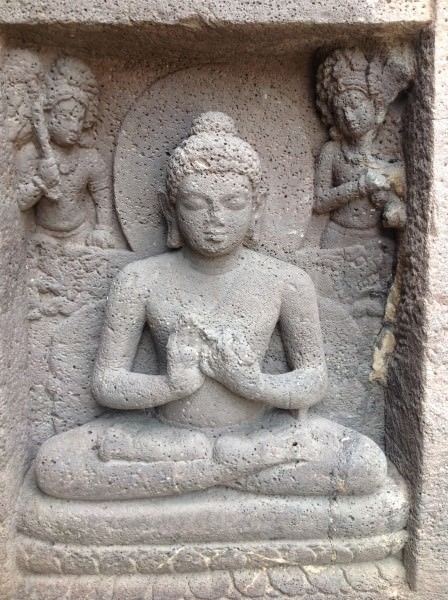
Seated Buddha Figure Displaying Dharmachakra Mudra
Cave 15A
This peculiar numbering is due to the fact that this was hidden under the rubble when the caves were being counted. This is the smallest vihara in Ajanta belonging to the early phase of excavation. It consists of a small central astylar hall with one cell on each side. Inside, the hall is relieved following the chaitya window pattern.
Cave 16
It is one of the largest excavations located at the centre of the arc of the ravine. An inscription records it to be a gift of the imperial Prime Minister Varahadeva. The colossal hall is surrounded by 14 cells. The garbha griha contains a sculpted figure of Buddha in pralamba padasana mudra. Some of the finest examples of murals are preserved here. Narratives include various Jataka stories such as Hasti, Maha Ummagga, Maha Sutasoma ; other depictions include conversion of Nanda, miracle of Sravasti, dream of Maya and other incidents from the life of Buddha.
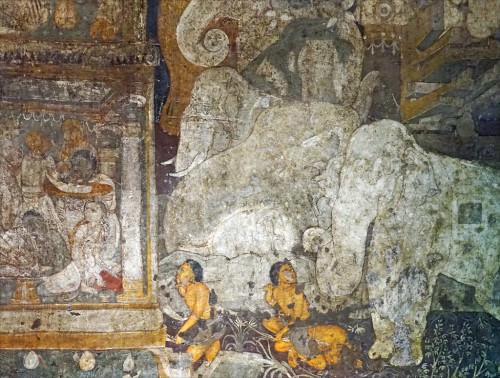
Jataka Story in Ajanta
Cave 17
An exemplary collection of paintings and architectural motifs is preserved in this vihara. Excavated under the benefaction of local feudatory Lord Upendragupta, this monastery typically consists of a pillared verandah with cells on either side, a large central hall supported by 20 octagonal pillars and bounded by 17 cells, an antechamber and the garbha griha with an enshrined image of Buddha.
Among the murals the profoundly poignant illustration of Chhaddanta Jataka, exquisite ornamentation of pillars and pilasters, the sublime depiction of graceful beauty of a lady looking at herself in a mirror and the evocative retelling of subjugation of Nalagari by Buddha are some of the highlights. Many Jataka stories are depicted here including Chhaddanta, Mahakapi (in two versions), Hasti, Hamsa, Vessantara, Maha Sutasoma, Sarabha miga, Machchha, Mati Posaka, Sama, Mahisa, Valahass, Sibi, Ruru and Nigrodhamiga.
Cave 18
This was mistakenly counted as a cave. It is a porch with two pillars having moulded bases and octagonal shafts.
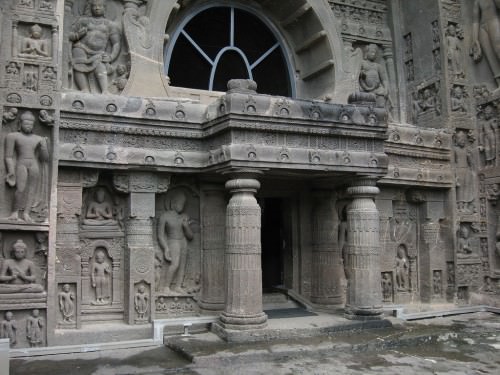
Cave 19, Ajanta, Deccan
Cave 19
The façade of this chaitya is splendidly decorated with various carved figures and decorative motifs. Buddha offering his begging bowl to his son Rahul is depicted close to the entry door. Also, two life size yaksha figures are sculpted on either side of the chaitya arch. Inside, the apsidal plan divides the space into a nave separated by a colonnade of 17 pillars from aisles with the apse at the terminal end housing the stupa. A standing figure of Buddha is carved at the front of the stupa whose umbrella-like crown almost touches the vaulted roof. The triforium is elaborated with figures of Buddha in different poses. The aisle walls still preserve some very beautiful mural paintings. Interestingly, the courtyard outside is flanked by two side porches.
Cave 20
Possibly donated by Upendragupta, this vihara consists of a verandah with a cell on each side and the interior hall is flanked by two cells on each side. The garbha griha houses Buddha in preaching attitude. A sculptural panel of note here depicts seven Buddhas accompanied by their attendants. Most interestingly, the central hall is astylar and the antechamber advances into the hall.
Cave 21
This vihara consists of a verandah with restored pillars, a hall with 12 pillars accompanied cells in equal numbers. Out of these 12 cells, four are supplied with pillared porches. Buddha in dharma chakra pravartana mudra is sculpted in the garbha grihaand traces of paintings on the wall show Buddha preaching a congregation.
Cave 22
The central hall of this vihara is astylar in form bounded by four unfinished cells. Carved in the back wall of the shrine Buddha is depicted in pralamba padasana mudra. Painted figures of Manushi Buddhas with Maitreya can also be noticed here.
Cave 23
Though unfinished this vihara is renowned for its intricately carved pillars and pilasters and naga (snake) doorkeepers. The whole structure comprises a verandah with cells at each end, an astylar hall with four cells, an antechamber with side cells, and the garbha griha.
Cave 24
Another incomplete vihara but the second largest excavation after Cave 4. The garbha griha houses a Buddha in pralamba padasana mudra but the cells bounding the central hall are unfinished.
Cave 25
An unfinished excavation at a higher level, the astylar central hall is not bound by any cell, also it is devoid of a garbha griha.
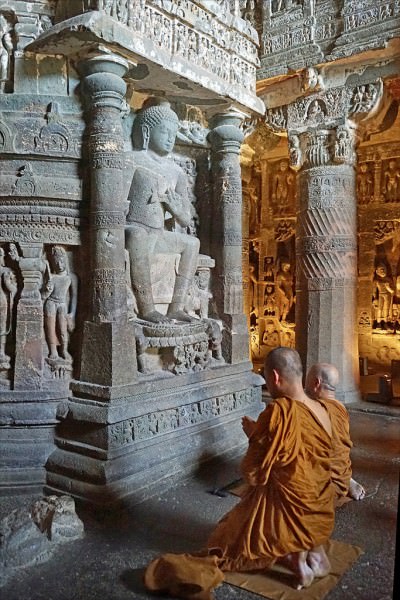
Stupa in Ajanta
Cave 26
This chaitya is famous for its striking depiction of Mahaparinirvana (demise) of Buddha on the left aisle wall along with the assault of Mara during Buddha's penance. Quite comparable to cave 17 but of grander and more elaborate design, an inscription on the front verandah records it to be a gift of Buddhabhadra, a friend of Asmaka minister Bhavviraja. The façade, inner pillars, trifolium, and aisle walls are all skilfully decorated. The stupa has a sculpted figure of Buddha in pralamba padasana mudra.
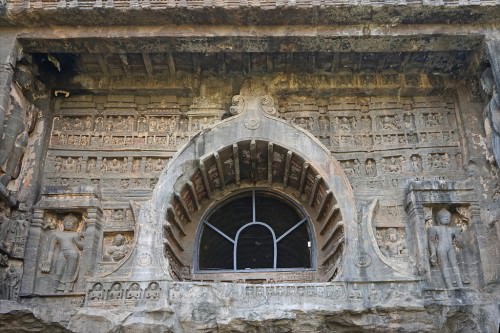
Façade of an Ajanta Cave
Cave 27
Possibly a part of Cave 26, this two-storied structure is a vihara. The upper storey is partially collapsed while the lower storey consists of an inner hall with four cells, an antechamber and garbha griha with an enshrined image of Buddha.
Cave 28
This is an unfinished vihara whose pillared verandah was only excavated before being abandoned. The cave is now inaccessible.
Cave 29
An unfinished chaitya, located at the highest level between Cave 20 and 21. This cave too is now unreachable.
Cave 30
This vihara was discovered during debris clearance between Caves 15 and 16. A small structure with a narrow opening, the inside hall is bounded by three cells.

Resting Buddha in Ajanta
REDISCOVERY & PRESERVATION
After centuries of neglect and desertion, the caves were accidentally discovered by John Smith, a member of a British hunting party in 1819 CE. With growing popularity within a few years of its rediscovery the once nondescript ravine became a soft target for unscrupulous treasure hunters. Before long, however, Indian antiquarian, archaeologist and architectural historian James Fergusson took a keen interest in their study, preservation and categorisation. It was he who commissioned Major Robert Gill to make reproductions of the paintings and together with James Burgess also numbered the caves.
Major Gill worked on 30 large scale canvases from 1844 to 1863 CE. These were displayed at the Crystal Palace in Sydenham, however, most of these paintings were soon destroyed in a fire in 1866 CE. John Griffiths, principal of the Bombay School of Art, was next commissioned to make copies of the paintings from 1872 CE onwards. It took him thirteen years to complete the project, but disaster struck yet again and well over a hundred canvases were incinerated in 1875 CE at the Imperial Institute.
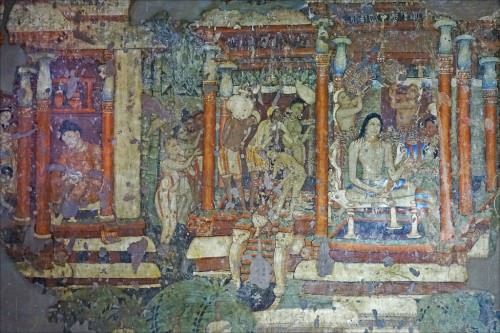
Murals of Ajanta Cave
Over the following decades Lady Christiana Herringham, Kampo Arai and Mukul Dey made noteworthy attempts at copying the paintings.
- Following the initiative of Ananda Coomeraswamy and William Rothenstein, Lady Herringham undertook the project and arrived at the site in 1910 CE. She was assisted by a team of contributors which included contemporary Indian artists Nandalal Bose and Asit Kumar Haldar among others. Lady Herringham worked mainly during the winter of 1910 – 1911 CE. The completed pictures were exhibited in 1915 CE by Indian Societies of Calcutta and London.
- Kampo Arai arrived in Santiniketan in the year 1916 CE; later he too proceeded to study and make copies of the murals of Ajanta. By a curious turn of fate his reproductions too were ruined while in storage at the Tokyo Imperial University following the earthquake of 1923 CE.
- Through an independent initiative noted Indian artist and photographer Mukul Dey visited Ajanta in early 1919 CE where he spent the next nine months making copies of the paintings. The experiences and adventures of this trip are fondly recollected in his book My Pilgrimages to Ajanta and Bagh.
- The celebrated Indian archaeologist Ghulam Yazdani worked tirelessly for many years from around 1920's CE for restoration and conservation of the caves and also made a comprehensive photographic survey of Ajanta.
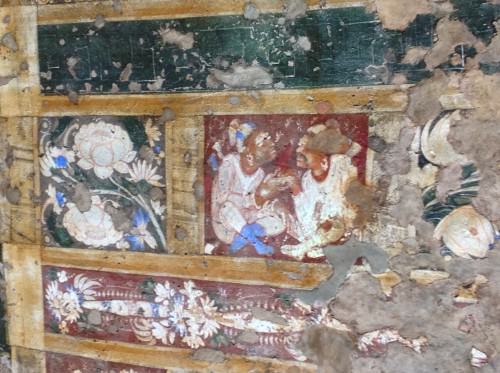
Two Traders in Discussion, Ajanta
Over a century and a half has passed since comprehensive scholarly studies were first undertaken at Ajanta. Any attempt to list the countless individuals whose unflagging pursuits to record, decipher and understand the many untold mysteries of the site, would be grossly incomplete. Nonetheless, pioneering work of a few individuals do stand out from a background of a teeming multitude. So, the following lines record the names of the historians and archaeologists whose patient work has illuminated many a dark niches and made it available to laity and connoisseurs alike.
- In the field of epigraphy, it was James Prinsep who first reproduced a few of the many inscriptions (over ninety has been recorded) in 1836 CE. Bhau Daji translated and added upon this collection when he visited the caves in 1863 CE. Other significant attempts that followed were by Bhagwan Lal Indraji, Georg Bühler, B Chhabra and Vasudev Vishnu Mirashi.
- Chronological study of Ajanta has become conterminous with Walter M Spink. Over a prolific career spanning five decades or more, he has meticulously reconstructed phase by phase the excavations of the later era under Vakataka Emperor Harisena. His comprehensive research has significantly reduced the arbitrariness of the dates and shed light on the many sociological and political influences that shaped the course of history in Ajanta.
- Dieter Schlingloff is widely recognized for his extensive study of the murals of Ajanta. Identification of the many tales of Jataka, their interpretation, iconographic significance and ties with Buddhist religion has been his life work. In many cases he has also received the able support of Monika Zin.
- Under Manager Rajdeo Singh, chief conservationist of ASI, over the last decade and a half, a painstaking restoration of the paintings of the caves 9 & 10 has been undertaken with marked success. Some of the murals that have lain hidden under grime, dust and misguided restoration efforts of a century ago can now be appreciated in their full beauty.
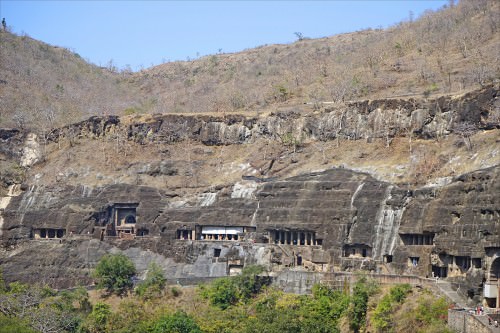
The Ajanta Caves
Though much has been irreparably damaged, a few debatable and, in all possibility, misplaced inferences have been drawn, it is through the combined efforts of many artists, archaeologists, historians, conservationists, geologists and antiquarians that the caves of Ajanta with all its grandeur and compassionate attitude continue to enthral and comfort the nameless many.
Alexander the Great: A Case Study in Martial Leadership › Antique Origins
Ancient Civilizations
History is not predictable; in many ways it can take on a life of its own. But sometimes, an individual's sheer presence is enough to bend history to his will. One such individual was Alexander the Great. Through his conviction, vision, mental dexterity, oratory, and superb physical endurance he was able to shape destiny, for himself and for the lands he conquered.
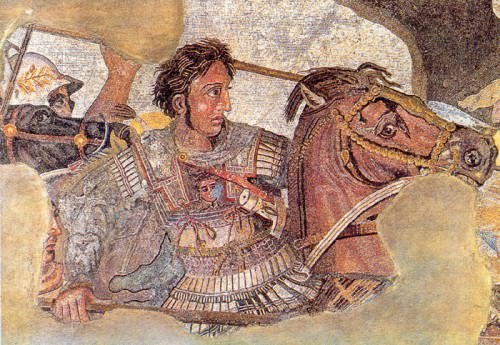
Alexander the Great
Even from a young age, Alexander showed maturity beyond his youth. His ability to conceptualize, anticipate, and take risks, was evident in his many victories. He persevered in Sogdia and in the Makran, hostile regions with vicious climates. Alexander maintained remarkable poise and exhibited leadership when all hung in the balance. When he took an arrow through the chest and another in the leg, he pressed on – the wounds only spurred him on to fight harder.
BATTLE OF GRANICUS : A LEADER (AND LEGEND) IS BORN
Alexander's battle at Granicus River was the most crucial military event in his life. Why would Granicus be more significant than the siege of Tyre, or the monumental battle of Gaugamela ? At the time, Alexander was a young 22-year-old king and general. As far as the enemy was concerned, let alone his own men, Alexander was unproven in battle and faced a superior Persian force, headed by a seasoned military commander, Memnon of Rhodes. In addition to his lack of experience and questionable leadership skills, Alexander's army, before even meeting the Persians in battle, was already at a disadvantage.The Persians had scouted the area meticulously and sought the high ground on the east bank of the Granicus River. Fighting a superior Persian army commanded by an able general would prove a daunting venture. But Alexander, despite his youth, was decisive in his plan of attack and confident in his own ability. His brilliance lay in his bravado and daring charges; bold troop movements would allow him the opportunity to exploit openings in his enemies' ranks. His ability to read his opponent and adapt quickly to changing circumstances was uncanny. It was an invaluable tool that would be put to the test at the Granicus River and determine his status as a warrior king.
According to Guy Rogers (lecture, Thomas Edison State College, Trenton, NJ, Spring 2004), the bank would have been three to four meters high, which would be difficult for Alexander's men to traverse without taking heavy casualties. Moreover, the Persians could rush the crossing cavalry and annihilate them through sheer force. This contingency was the beginning of his prowess, so instead of an en masse movement across the river, an additional force would engage the Persians and make a pawn's sacrifice for Alexander and his men.
Amyntas and his cohort confronted the Persians while Alexander and his cohort swung around and penetrated the Persians from the flank. Alexander's intentions were realized when the Persians failed to engage the rest of his men with the same devastating force that they had unleashed on Amyntas. The situation for which Alexander had hoped opened up before his very eyes. Amyntas had given Alexander the opportunity and time to lead the Companion cavalry, Alexander's choicest warriors, into battle.
ALEXANDER'S BRILLIANCE LAY IN HIS BRAVADO AND DARING CHARGES; BOLD TROOP MOVEMENTS WOULD ALLOW HIM THE OPPORTUNITY TO EXPLOIT OPENINGS IN HIS ENEMIES' RANKS.
The Persian commander Mithridates met Alexander's assault and Alexander dealt with him like he would deal with many to come, he struck him in the face with a splintered spear. Alexander had killed a Persian commander in full sight of his men; a slight that would not go unanswered. Rhosaces and Spithridates, the brother of the slain Mithridates, pursued Alexander to finish the young upstart once and for all. Alexander was quick to react. He took the offensive against Rhosaces and gored him, but he inflicted a potentially fatal blow that left Alexander's scalp loosely intact. Disoriented and cleaved, Alexander did his best to get back to his men, all the while oblivious to Spithridates stalking close behind. As Spithridates came in for the kill, Cleitus cut him off and severed his shoulder from his body, thereby immobilizing the arm that held the scimitar that would have ended Alexander's great campaign before it had even begun.
It was a momentous victory, not because Alexander had been outnumbered two to one, which he was not, but because this was the battle which proved his ability as a capable commander and legitimated his rule as king. He had shown his men that he was a shrewd military commander and that he cared deeply for them. The 25 bronze statues commissioned by Alexander to Lysippus as grand memorials to brave Macedonians evidence this. Alexander also sent 3,000 suits of armor back to Athenswith the inscription: "Alexander son of Philip and the Greeks, except the Spartans, from the barbarians who dwell in Asia."
But more importantly, Alexander laid the foundations of a relationship that would prove itself time and again until his death.After the battle, Alexander talked with many who had been wounded and asked them to tell him of their individual roles in the battle and how they received their wounds. By doing this, he formed an indestructible bond between him and his men. That bond would prove his greatest strength in the most trying times. Robin Lane Fox sums up Alexander's role in Granicus:
The bravery which bordered on folly never failed him in the front line of battle, a position which few generals since have considered proper; he set out to show himself a hero, and from the Granicus to Multan he left a trail of heroics which has never been surpassed and is perhaps too easily assumed among all his achievements.(495-496)
SOGDIANA & THE SOGDIAN ROCK
The hinterlands of the Persian Empire were remote and autonomous. They might even be said to be independent of Darius ' rule. After Darius' death, Alexander, the newly crowned “King of Asia” saw fit to reestablish dominion over this insufferable region called Sogdia. Even though this adventure cost him two years of his life, the loss of many men, and extreme hardship throughout the whole ordeal, Alexander was able to press these obstinate barons as only he could. One of the most notable sieges occurred at the 'Sogdian rock'. Here his men were asked to literally 'fly' before the local barons would submit.Alexander's men did fly and perched themselves on the top of an adjoining mountain in full view of the besieged, which frightened the locals into a quick surrender. The second rock was more inaccessible, and even though the baron Sisimithres did not know it, it was impregnable. He was coaxed into submission by the baron of the first Sogdian rock, Oxyartes.Alexander's daring feat led to his victory and he was given access to Sisimithres' largess, which included a large store of badly needed foodstuffs. Alexander's army would eat until their bellies were content; they had endured trials and hardships that left them little more than ghosts of their former selves. This was a welcome respite where they could enjoy the fruits of their labor – no matter how ephemeral. While his ambitions lay in conquering all who stood before him, Alexander was confronted with the prospect of leaving his newly won kingdom to his subordinates. This would not do. Alexander needed to secure his conquestby having an heir to pass his kingdom to. Oxyartes' daughter, the enchantress Roxane, was a likely, if not foolhardy, choice.
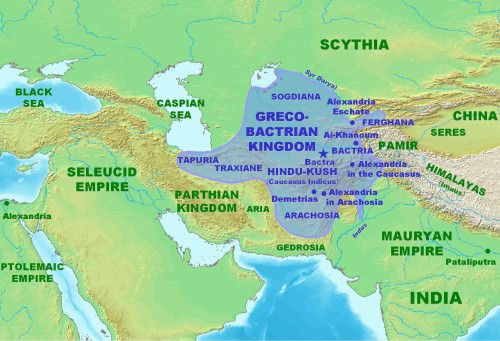
Map of the Greco-Bactrian Kingdom
ALEXANDER'S GREATEST CHALLENGE – THE MAKRAN
According to Fox, "Not even the sum total of all the army's sufferings in Asia deserved to be compared with the hardships in Makran." (399) Makran was a wasteland if there ever was one. Between the accounts of Alexander's own officer, Nearchus, as well as the descriptive accounts of Fox and Green, a very uninviting picture is pieced together. Alexander's plans to invade India had been thwarted by the mutiny at Hyphasis. If he could not sate his ambitious desires in India, then he would return to the heart of the Persian Empire in grand style – through the Makran, the most infamous route to Mesopotamia. Queen Semiramis and King Cyrus are the only ones to have ever traversed it. Alexander saw this as a great opportunity to defy nature and fueled his mania to rival the feats of the gods. He was an adventurer and explorer at heart but knew he needed to be fully prepared to meet the challenges that lay ahead. He weighed historical reports with present intelligence and planned for most contingencies.
ALEXANDER WAS A DREAMER; HE BELIEVED HE WAS FATHERED BY A GOD AND THOUGHT THAT NO FEAT WAS IMPOSSIBLE.
Still in the Punjab, Alexander assembled a fleet of ships that would accompany him by sea while he and his army traveled by land. Alexander was a dreamer; he believed he was fathered by a god and thought that no feat was impossible. But did he really know what he was getting himself and his men into by venturing into the Makran? Probably not, but his ingenuity and god-like example, a stellar feat under adverse conditions, must have been a great boost in morale for the men. If Alexander would even think of attempting such a gamble, then it must be possible. His men knew that whatever he conjured came to fruition. He had yet to know defeat, so why should this situation be any different?
Makran would be a "severe test", and probably this was the allure for Alexander. (Fox, 390) Knowing that others had attempted such a crossing and came out alive proved irresistible. He could not pass it up without surpassing such a feat. Throughout the journey, Alexander led by example even though he was suffering from a significant injury to his lung from an arrow back at Multan. One anecdote retold by Peter Green captures an inkling of the character of Alexander and the effects on morale are impressive:
Nevertheless, [Alexander] contrived to preserve his prestige and popularity by sharing the men's worst hardships. Once, when a helmetful of muddy water had been found for him in some nearby gully - but no more was to be had - he laughed, thanked the donor, and then tipped the water out into the sand. So extraordinary was the effect of this action that the water wasted by Alexander was as good as a drink from every man in the army. (434)
This gives us a glimpse into the enigmatic nature of Alexander, a man we can only hope to aspire to in times of hardship and a man we can only come to know through the eyes of those who knew him best.
Fox sums up Makran and Alexander's reasons for enduring it:
Makran was the ambition of men who wished to set a record and had nothing left to conquer but a landscape which Persia had left alone. The route was not merely difficult; it was the most hellish march that Alexander could possibly have chosen. But nobody opposed it. (403)
The most telling bit of information is the last sentence of that quote, "But nobody opposed it." Why did not anyone oppose it?The answer can be traced back to the River Granicus, where Alexander had won his men's loyalty and love for all time. He was the man everyone wanted to be and the man no one could refuse. At the end of their quest, they saw the "hill of Semiramis". It was a memorial for those who had come before and a relief to those who now passed by. "Semiramis' name greeted the survivors, so she could be said, for solace, to have gone through the desert too." (Fox, 402) But, in Alexander's defense, he did not come out with a mere twenty survivors but thousands.
REIMAGINING THE FUTURE: WHAT IF ALEXANDER HAD LIVED LONGER?
If Alexander had lived longer, he surely would have continued to indulge his thirst for conquering by going south into Arabia, north into the lands surrounding the Caspian, and West into North Africa. It is reasonable to assume that if he had lived, those countries would have been conquered in due time. Future campaigns had already been seriously considered and planned before his death in Babylon and were probably first conceived after Hephaestion ’s death at Hamadan. If he could triumphover the greatest empire in the known world in under a decade as a neophyte, just think what he could do at the height of his power. If Alexander had lived to an age comparable to Parmenio's, the ancient world might have been far different from what is recorded in history textbooks.
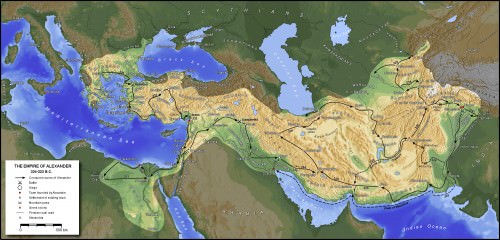
The Empire of Alexander the Great
If Alexander's past record tells us anything, it is that those who he conquered had little to fear if they accepted his rule. He traditionally incorporated others' beliefs and practices into his own and often pushed them to the forefront. There were many precedents to favor such actions. However, there was one thing that native peoples might have had to fear - relocation and migration. While they might be allowed to keep their customs and their religions, they might be asked to 'mix' with other ethnic groups, like Macedonians, Greeks, and Persians. This was one of Alexander's last wishes, so it may have been implemented somewhere down the line.
Alexander would have been his empire's greatest strength. Like Napoleon, his presence was worth 30,000 men. The loyalty of all his men would have been crucial – which may have ultimately been his Achilles heel. Palace intrigue plagued the RomanEmperors and as Alexander's empire grew, his would be no exception. The more his ambitions dictated him, the more he became a slave to his own desires.
Alexander slowly but surely moved his way to be seen as a god, not as a king. It is possible he would have ruled as Ptolemy did in Egypt. It is reasonable to suggest that eventually he would be revered by all as a living god, not just as a son of a god.He was already depicted as divine on coinage and in song. Eventually, Alexander's empire, upon his death, would have been left to either his son or his appointed successors. His successor, in order to keep everything in order, would have to possess some of Alexander's qualities, particularly his military prowess, magnetic personality, and persuasive manner, the army's loyalty being essential. The dissolution due to the lack of such an heir was evident after Alexander's death and took a generation to end.
ALEXANDER REMEMBERED
This is the story of Alexander who traveled to the ends of the earth on a quest for conquest, glory, and a lasting fame that would surpass Achilles and the heroes of old. The idea to make the world his footstool was not a mere wish but a reality.Alexander knew that if he only thought of it, his men would see it through as long as he could win them over. Fox eloquently paints a stunning portrait of who Alexander was and continues to be in our hearts and minds:
He was famously generous and he loved to reward the same show of spirit which he asked of himself...Though he drank as he lived, sparing nothing, his mind was not slurred by excessive indulgence; he was not a man to be crossed or to be told what he could not do, and he always had firm views on exactly what he wanted.He was also a man of passionate ambitions, who saw the intense adventure of the unknown. He did not believe in impossibility; man could do anything, and he nearly proved it. Born in a half-world between Greece and Europe, he lived above all for the ideal of a distant past, striving to realize an age which he had been too late to share. (496-497)
Alexander has yet to be rivaled by man since his rule in the 4th century BCE. "Alexander's true genius", observes Green (488), "was as a field-commander: perhaps, taken all in all, the most incomparable general the world has seen." It is only a pity that Alexander did not have a Homer to record the greatness of his deeds and the guarded secrets of his heart. As Green concludes,
Yet his legend still lives; the proof of his immortality is the belief he inspired in others. That is why he remained greater than the measurable sum of his works; that is why, in the last resort, he will continue an insoluble enigma, to this and all future generations. (488)
If so, maybe we would hold in high esteem the hero of the classic Alexander the Great, instead of the heroes in the classic works of the Iliad and Odyssey. Alexander would have been delighted to rival the heroics of Achilles in a work retold from father to son through the generations. Thereby his memory and deeds would be remembered for all time.
LICENSE:
Article based on information obtained from these sources:with permission from the Website Ancient History Encyclopedia
Content is available under License Creative Commons: Attribution-NonCommercial-ShareAlike 3.0 Unported. CC-BY-NC-SA License